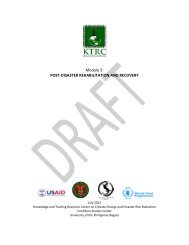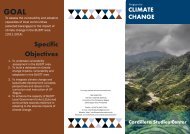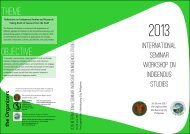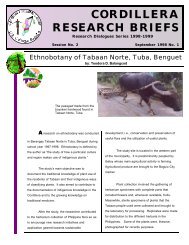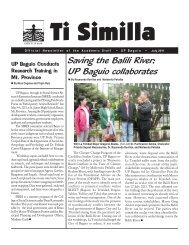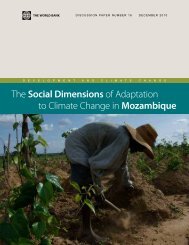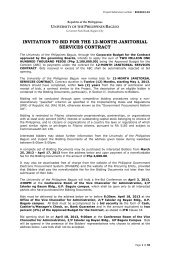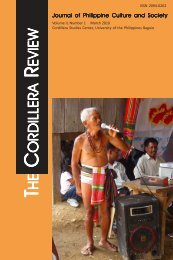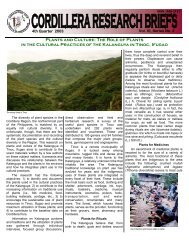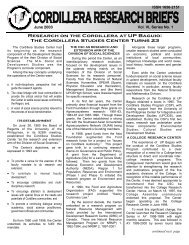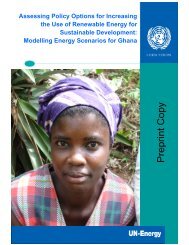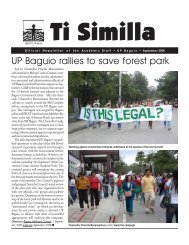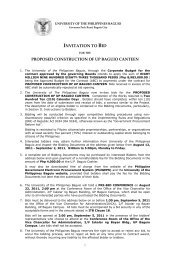Pambansang Summit sa W ambansang Summit sa W ... - UP Baguio
Pambansang Summit sa W ambansang Summit sa W ... - UP Baguio
Pambansang Summit sa W ambansang Summit sa W ... - UP Baguio
You also want an ePaper? Increase the reach of your titles
YUMPU automatically turns print PDFs into web optimized ePapers that Google loves.
April Timek : Part I<br />
Air Quality in the City<br />
Air quality is measured by the levels<br />
of certain ambient air pollutants that are<br />
major environmental health hazards.<br />
These include particulate matter - total<br />
suspended particulates (TSP) and PM 10 ,<br />
carbon oxides (CO and CO 2 ), nitrogen dioxide<br />
(NO 2 ), sulfur dioxide (SO 2 ), Ozone<br />
(O 3 ), among others. The Philippine Clean<br />
Air Act of 1999 sets standards for TSP,<br />
PM 10 , CO, NO 2 and SO 2 . The connection<br />
between the deterioration of air quality<br />
and human health impacts is fairly established.<br />
From Cassidy et al. (2007):<br />
Epidemiological studies show<br />
that there is a close correlation<br />
between exposure to air pollutants<br />
and mortality and morbidity,<br />
including asthma, chronic<br />
obstructive pulmonary disease,<br />
cardiovascular disease, lower<br />
birth weights, cancer, and premature<br />
births. Furthermore, particulate<br />
matter generated from combustion<br />
processes, particularly<br />
diesel exhaust particulates, are<br />
highly toxic and often result in<br />
more exacerbated health effects.<br />
Focusing on particulate matter (PM)<br />
standards, total suspended particulates<br />
(TSP) refer to particulate matter with aerodynamic<br />
diameter between 20-50 micrometers.<br />
PM 10 , on the other hand, refers<br />
to particles with aerodynamic diameter<br />
less than 10 micrometers, which may<br />
4 TI SIMILLA April 2011<br />
Column<br />
Reclaiming <strong>Baguio</strong>’s Pristine Air<br />
and Green Environment: Would it Make Economic Sense?<br />
By Achilles Costales<br />
Table 1. Comparative standards for Air Quality for PM 10 and TSP.<br />
(In µg/m 3 )<br />
reach the upper part of the airways and<br />
the lungs. Standards on critical values of<br />
PM 10 are set for maximum allowable exposures,<br />
in micrograms per cubic meter<br />
(µg/m 3 ), on a short-term basis (24-hr<br />
mean) and long-term basis (annual mean).<br />
Long-term critical values are lower than<br />
the short-term standards. Table 1 compares<br />
the standards for particulate matter<br />
adopted by the Philippines (CAA 1999),<br />
the European Union (EU), and the UN<br />
World Health Organization (WHO). For<br />
PM 10 , both the EU and WHO standards<br />
are more stringent than those precribed<br />
in the 1999 CAA of the Philippines.<br />
The EU Directive also imposes that<br />
the number of days in which the shortterm<br />
limits are breached should not exceed<br />
35 days within a given year. In addition<br />
to its Air Quality Guideline (AQG),<br />
it also sets graduated interim targets (IT’s)<br />
for the short-term PM 10 levels, between<br />
50 to 150µg/m 3 , and for the long-term levels,<br />
between 20 and 70µg/m 3 . These targets<br />
correspond to the magnitudes of increased<br />
mortality risks associated with<br />
larger values of the IT’s. For the 24hr<br />
standard, remaining in the lowest-level<br />
target of PM 10 not exceeding<br />
150µg/m 3 implies an average increase<br />
of about 5% in short-term<br />
mortality risk over the levels associated<br />
with meeting the 24-hr AQG.<br />
For the annual standard, staying at<br />
the lowest-level target of PM 10 not<br />
exceeding 70µg/m 3 implies an aver-





